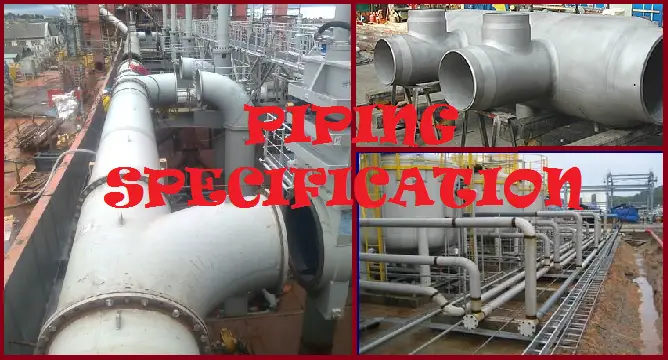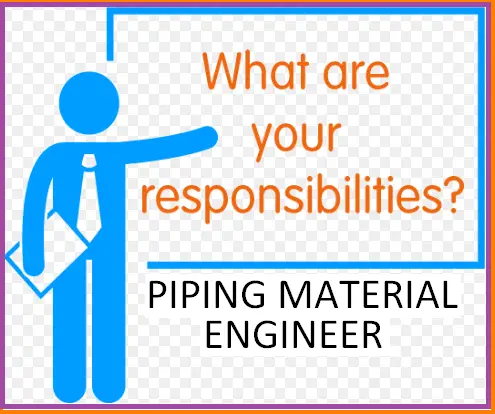What is a Piping Specification?
Piping Specification (pipe spec, in abbreviated form ) is the most important piping document for a project that is prepared during the design phase of any project. They provide all the basic guidelines that need to be followed while proceeding with the design of the project.
The Function of a Piping Specification
Piping Specifications are engineering documents, generated by design consultancies to cover additional requirements applicable to a specific product or application. Piping Specs provides specific/additional requirements for the materials, components, or services that are beyond the code and standard requirements and based on engineering experience and best practices of the design companies.
Types of Piping Specifications
In Piping Design Companies/Consultancies, more than twenty-five (25+) Specifications (most of the time they are referred to as pipe spec, in abbreviated form) are used that cover piping-related issues. There will be a “piping specification” for:
- Piping Layout and Design
- Engineered Spring Supports
- Site Fabrication and Installation
- Hydrotesting and Pneumatic Testing of systems
- Shop Fabrication
- Hot, Cold, and Acoustic Insulation
- Pipe Support Standard
- Pipe/Line Class Material
- Special Pipe Supports Design
- Valve Purchasing
- Flexibility Specification
And the list does not end here…….
This partial list provides some of the specific piping specifications that are found on most projects in design companies.
How to Make a Pipe Material Specifications?
All Piping Material Class Specifications must have a front cover with a written section containing the following:
- Document Title
- Document Number along with Revision history
- Name of Responsible person, checker, and approver along with creation date
- Contents in Tabular or properly arranged format
- Functional or Purpose Statement
- General Notes
- A list mentioning all the applicable Codes that apply to the materials added in the specification
- A list specifying the Line Classes with data like Material, Commodity, Flange Rating, etc.
- All individual Line Class sheets
- All common drains, vents, and other miscellaneous details with the proper connection.
- Header and Branch Connection Tables
All of this will then be issued as a single document with the title “Piping Material Specification” or PMS.

Basic Data Required for Piping Material Specification
Data Requirements for Pipe Material Specification
The piping material engineer will need the following information:
- List of all commodities like feed, all products, all waste streams, all utilities, and all additives that are part of the project.
- Complete chemistry of each commodity which includes Toxic classifications and reactions to changes in temperature.
- Maximum sustained operating pressure and temperature of every commodity. Also, Any short-term or upset condition that may cause an increase or decrease in pressure or temperature.
- Corrosion rate for different pipe materials when in touch with the above commodities.
- Expected maximum and minimum pipe size (Nominal Bore) for the project.
- Jobsite Location with environmental conditions.
This is just the start. Now the engineer should know the governing piping code:
- ASME B31.1 i.e, Power Piping
- ASME B31.3 i.e, Process Piping
- Or any other Code?
The next importance is in knowing the Client’s preferences and or restrictions for materials, valves, flanges, or any other items.
Next, required to know the expected “Design Life” of the plant to determine the corrosion allowance for selecting the final pipe schedule.
Now to prepare the finished “ Piping Line Class” or “piping material specification”, The Engineer may create a word or excel document with the following headers:
- Block indicating piping class details and revision status
- Item
- Pipe Nominal Size (in inches or Metric units)
- Wall Thickness or Pipe Schedule
- Design limitations and Pressure temperature limits.
- End Connection Type
- Branch connection table
- Bolt and gasket details for various types of flanges.
- A short description of a piping component, not a full purchase description.
Vertically the first column (Item) will be divided into “Pipe”, “Fittings”, “Flanges”, “Gaskets”, “Bolts”, and “Valves”
Within this column, the “Fitting” section and the “Valve” section would be divided to cover the various items normally required based on size.
“Fittings” would include:
- 90-degree Elbows
- 45-degree Elbows
- Straight Tees
- Reducing Tees
- Caps
- Unions Etc.
“Valves” would include:
Other information that needs to be included in a line class/ material class includes.
- Temperature Limits
- Basic Construction of 2” and smaller Screwed/ 3” and Larger Flanged and Butt-welded, etc.
- Flange Rating, etc.
What is a Piping Class?
A piping class is defined as an assembly of piping components that are suitable for a defined service and design limits within a piping system. The piping class or Pipe Class is an important document that specifies all the required components under a specific design limit. Typical components that are covered in a piping class are the type of pipe, material, schedule, corrosion allowance, flange ratings, branch types, valve types, valve trim material, gasket, and all the other components’ specific requirements.
Pipe class development mainly considers the Design and Operating Pressure, temperature, and corrosive environment. Different piping material specifications are segregated into separate “Piping Classes”. Pipe class is included in the line number to help engineers easily identify the MOC of each piping item.
What are the advantages of a Piping Class?
The generation of piping class provides multifold benefits to plant design engineers. Some of the advantages of designing and purchasing piping following piping classes are listed below:
- A large reduction in piping system engineering and procurement effort due to internal design standardization.
- Group-wide standardization of piping material and piping systems design;
- Variety control which leads to reduced costs for stocking materials;
- Integrity and Quality control in relation to applied standards;
- Increased leverage for centralized purchasing;
- Reduction of the risk associated with wrong material selection.
Differences between Piping Specification and Piping Class
Here’s a tabulation of the major differences between a piping class and a piping specification:
| Aspect | Piping Class | Piping Specification |
|---|---|---|
| Definition | A piping class is a collection of related piping components, defined for a particular application or service. | A piping specification is a document that provides detailed information about the requirements and standards for piping materials and components. |
| Purpose | A piping class is used to group and categorize piping components for ease of design, procurement, and installation. | A piping specification is used to define the technical and material requirements for the components used in piping systems. |
| Scope | A piping class typically includes a set of materials, components, and accessories organized for a specific type of service or environment. | A piping spec. focuses on the technical details, including material grades, dimensions, and pressure ratings for piping components. |
| Components Included | Includes pipes, fittings, flanges, valves, and supports, often categorized by service or fluid type. | Includes detailed descriptions of pipe materials, wall thicknesses, pressure ratings, and other technical specifications. |
| Detail Level | Generally broader, categorizing components and materials based on service requirements. | More detailed, providing specific standards and requirements for each component. |
| Usage | Used by designers and engineers to select and use components based on the type of system or service. | Used by engineers and procurement teams to ensure all components meet the required standards and specifications. |
| Documentation | May include tables, diagrams, and descriptions to categorize components. | Usually a formal document or set of documents detailing technical standards, material requirements, and testing procedures. |
| Customization | Can be customized based on project needs or industry standards, reflecting the specific requirements of a project. | Highly specific, based on industry codes, standards, and project requirements, with less variation. |
| Examples | A class for high-temperature steam service, including appropriate materials and components for that service. | A specification detailing the requirements for carbon steel pipes, including allowable pressure ratings and material grades. |
Both piping classes and piping specifications are critical for designing and maintaining effective and reliable piping systems, but they serve different purposes and provide different types of information.
Who is responsible for generating Piping Material Specification?
Piping material engineers prepare the piping material specification and piping classes by discussing with process engineers. Most of the data required for producing a pipe material class is received from the process team.
About the Author: This article has been prepared by Dr. Javier Blasco Alberto, Associate Professor, School of Engineering and Architecture, University of Zaragoza. He also collaborates actively with InIPED.









Hi Anup
Thanks for the blog . Your info with respect to the Piping Material Engg is very useful and always in details . I have also developed some useful Piping Notes which is helpful for every material engineer getting inspired by you .
Thanks
Nikunj
Singapore
Hi Anup,
I am a chemical engineer and i have a question,
what type of documents you require from process team to prepare PMS
Fluid List(Contains all fluid type and process parameters), basic of MOC…etc
How can piping class A23A,A93AU, A3ALU be interpreted